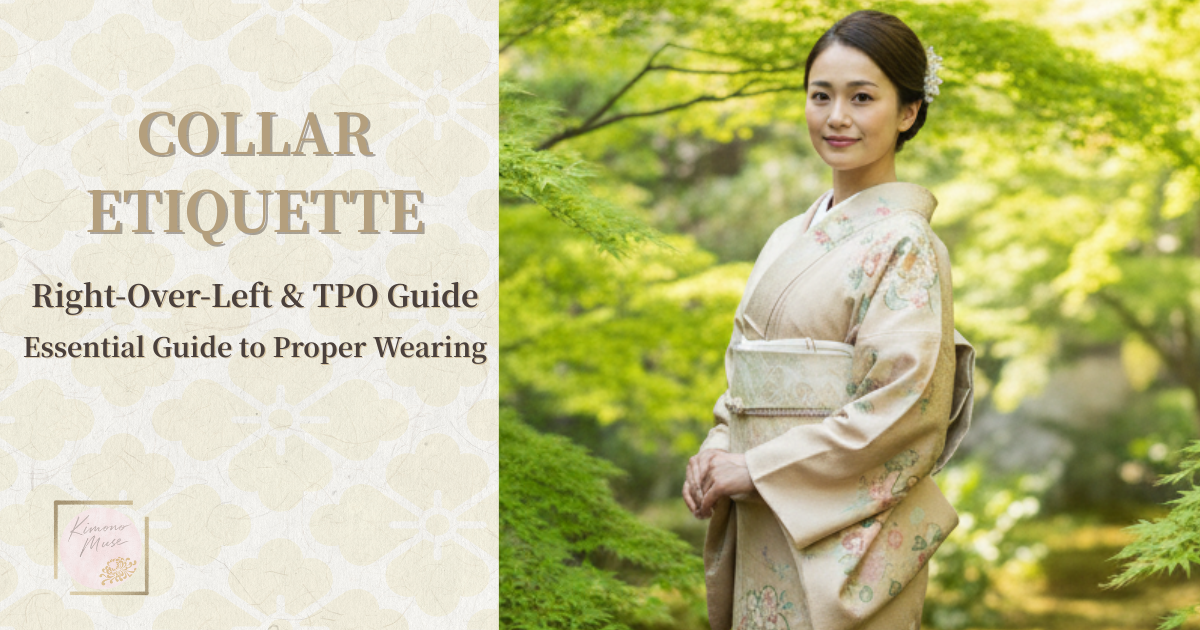“Wait, which side goes on top for a kimono collar?”
Have you ever found yourself suddenly unsure while getting dressed in a kimono?
That small moment of hesitation can actually change the entire impression of your kimono look.
Among all the rules of kimono dressing, “right over left” and “left over right” are especially important—mixing them up is something you must avoid.
In this article, we’ll clearly explain the basics of kimono collar alignment, so anyone can understand it with confidence.
You’ll also learn some practical tips from real dressing experiences—simple tricks to remember which side goes on top, and how to adjust the collar for different occasions to create the right impression.
Be sure to read to the end for easy, memorable guidance that will make your kimono dressing smoother and more elegant.
The Meaning of Right-Over-Left and Left-Over-Right
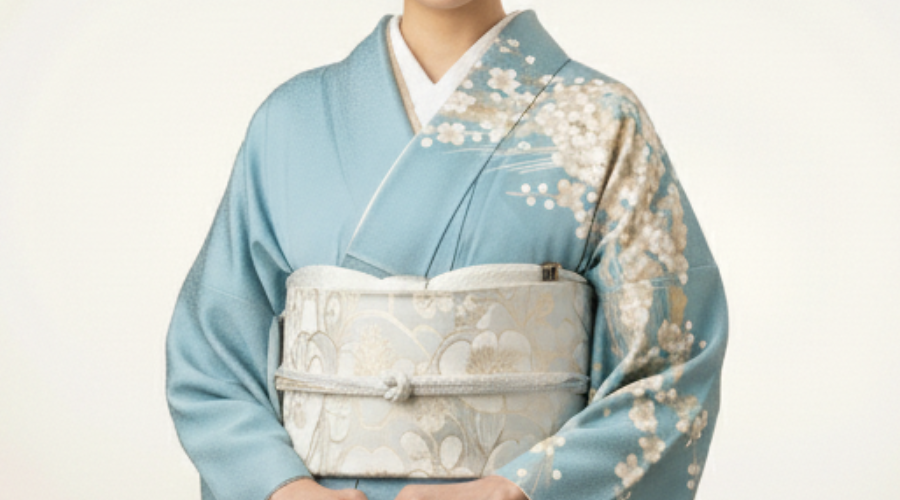
The terms “migi-mae” (right-over-left) and “hidari-mae” (left-over-right)* can be a little confusing at first.
Let’s start by clearly understanding what each of these expressions actually means.
Right-over-left (Migi-mae):
From the viewer’s perspective, the right collar comes to the front of your body. In other words, the left collar overlaps on top.
This is the correct and traditional way to wear a kimono.
Left-over-right (Hidari-mae):
The opposite—the left collar comes to the front of your body, meaning the right collar overlaps on top.
This alignment is used only when dressing the deceased and must never be worn in daily life.
When we wear a kimono in daily life, the correct way is always “right over left.”
You might wonder, “But why is that the rule?”
This custom actually has a very long history. It’s said to have originated from an ancient Japanese law established during the Nara period (710–794)—specifically, in the “Ebukuryō” (衣服令), a section of the Yōrō Code that regulated clothing and dress.
From that point on, Japan adopted the continental custom of wearing garments “right over left.” Over time, this practice evolved into a uniquely Japanese tradition, one that has been carefully preserved and passed down all the way to the present day.
Why Left-Over-Right Must Be Avoided
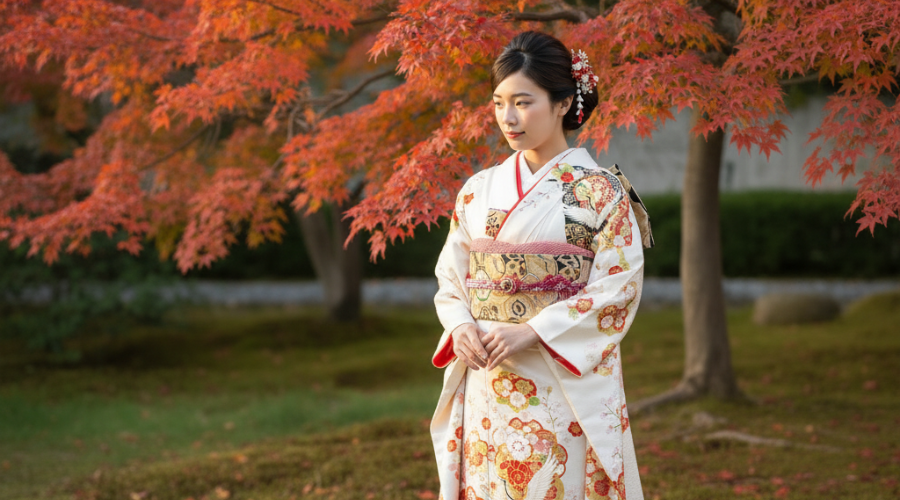
So why is “right over left” considered correct, while “left over right” must absolutely be avoided?
The answer lies deep in Japan’s traditional view of life and death—its ancient shiseikan, or philosophy that separates this world from the next.
Since long ago, when preparing someone who had passed away for their final journey, the deceased was dressed in left-over-right style. This was known as shinishōzoku (死装束), the clothing of the dead. It served as a symbolic distinction between the living world (ukiyo) and the world beyond (anoyo).
Because of that, wearing left-over-right while alive came to be seen as inauspicious—a gesture associated with death rather than life.
But the reasoning isn’t only cultural or spiritual. It also affects how you look.
When the collar is reversed, the balance of the kimono feels off—somehow untidy, restless, even a little awkward to the eye. The familiar symmetry of right-over-left has a visual harmony that expresses grace and composure.
Imagine looking back at your cherished photos from a coming-of-age ceremony or a wedding and realizing your collar was reversed—“Wait, why does it look a little messy?” That would be heartbreaking after all your care and effort.
To preserve both the elegance of tradition and the beauty of the moment, remember this simple rule:
Left-over-right is only for the dead. For the living, right-over-left is the way to go.
Follow that, and you’ll never make a major kimono mistake again.
How to Remember the Correct Collar Overlap
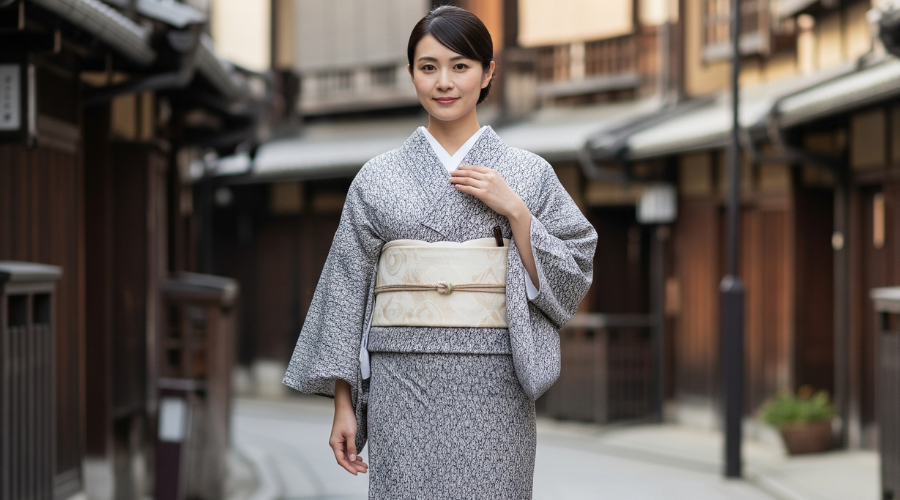
Even if you know the difference between right-over-left and left-over-right, it’s surprisingly easy to hesitate once you’re actually dressing in a kimono.
Especially for those who don’t wear kimono often, the sense of collar alignment doesn’t come naturally.
Here are some easy ways to remember it clearly every time.
❀ Think of the collar as the letter “y”
When viewed from the front, the neckline should form the shape of a lowercase “y.”
If you remember it as “y for you”—meaning, from the viewer’s point of view—it naturally becomes right-over-left.
It’s a simple visual cue that sticks in your mind after just one try.
❀ “Your right hand should slip easily into the front fold”
The kimono was traditionally designed to match the movement of right-handed people.
When worn correctly, your right hand can smoothly slide into the front opening (futokoro).
If you’re unsure, simply try it—whichever way allows your hand to go in easily is right-over-left.
Interestingly, this is the opposite of how Western clothing buttons work—so you can also remember it as “the reverse of Western wear.”
❀ The more decorative side goes on top
Kimono patterns are designed to look most beautiful from the viewer’s perspective.
When the more colorful and ornate side of the pattern is on top, it almost always results in the correct collar alignment.
This is especially useful for formal kimono such as homongi (visiting kimono) or furisode (long-sleeved kimono).
Simply think, “Which side do I want to show off?”
If the more elegant pattern ends up on top—and it forms that familiar “y” shape—you’ve got it right.
Tips to Keep in Mind
❖ Watch out for mirrored photos
Smartphone front cameras sometimes flip the image. Even if you are wearing the collar correctly as right-over-left, the photo may appear reversed as left-over-right. Always double-check before posting on social media.
❖ Always right-over-left—even for undergarments and yukata
The same rule applies to everything: undergarments (hadajuban and nagajuban) as well as summer yukata. In all forms of traditional dress, right-over-left is the absolute rule to remember.
Even in kimono dressing schools or beauty salons, the first instruction you’ll always hear is:
“Remember, it’s right over left.”
That’s how essential this rule is.
Once you’ve memorized it, you’ll never hesitate again—and that confidence will make dressing in kimono feel calm, smooth, and enjoyable every time.
Kimono Collar Etiquette: Dressing for Time, Place, and Occasion
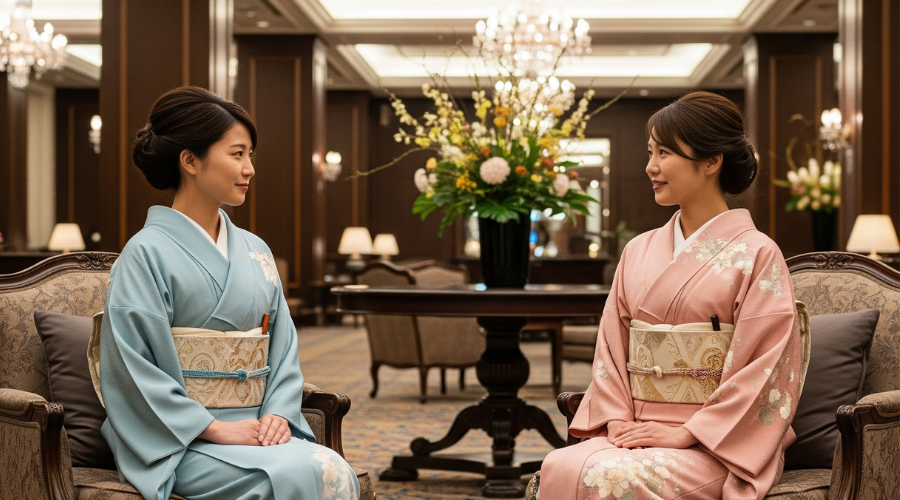
Just like in Western clothing—where you might think, “Should I button the top of my shirt or leave it open today?”—there are also TPO-based rules (time, place, occasion) for kimono collars.
By making small adjustments to how you align or open the collar, you can completely change the impression your kimono gives.
✿ Formal occasions (such as weddings or coming-of-age ceremonies)
For formal settings, the collar should be neatly aligned and form a nearly right angle at the neckline.
This creates an impression of cleanliness, dignity, and composure—perfect for solemn or celebratory events.
When worn this way, the overall look feels refined and elegant, giving you a poised, confident presence that naturally makes you stand taller.
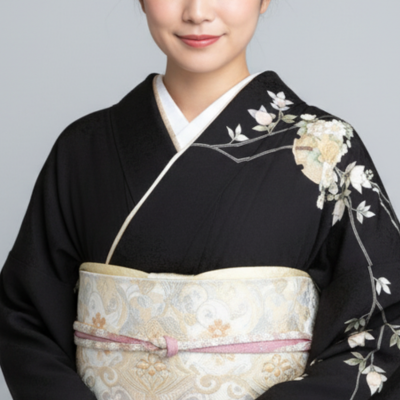
✿ Casual occasions (such as lunch or dinner with friends)
Loosen the collar slightly and create a softer, more open angle at the neckline.
This relaxed look avoids stiffness and adds an effortless charm, giving off a friendly and approachable impression.
It’s a subtle way to express casual elegance—stylish, yet comfortably natural.
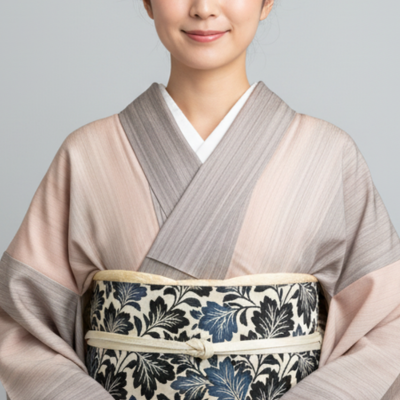
✿ Everyday kimono style
When wearing kimono in daily life, adjust the collar angle to suit your age and body type for a beautifully balanced look.
For younger or slender wearers, a sharper, near-right-angle neckline creates a clean and elegant impression.
For mature or fuller figures, a **gentler angle—around 60 degrees—**gives a softer, more natural look that feels relaxed yet refined.
Small adjustments like this bring harmony to the entire silhouette and make your kimono feel truly your own.
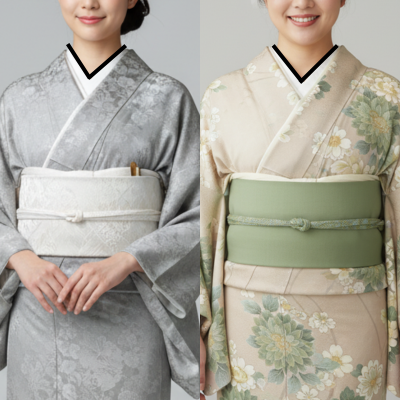
It’s fascinating how just a slight change in the collar angle can completely transform the overall impression of your kimono.
Once you become aware of the appropriate angle for each occasion, you’ll naturally give off a refined, experienced aura—the kind that makes people think, “She really knows how to wear kimono.”
For example, even when wearing the same homongi (visiting kimono), a neatly closed collar gives a sharp, intelligent look, while a slightly loosened one creates a soft, gentle impression.
These subtle adjustments are what make kimono so captivating—the joy of expressing your individuality through quiet, graceful details.
Conclusion
Let’s take a moment to review the key points about kimono collar alignment.
The foundation is simple: always wear the collar right-over-left.
Remember that left-over-right is reserved for the deceased—an important cultural distinction rooted in tradition.
And finally, even the angle of your collar can transform your overall look, allowing you to express your personality with elegance.
By understanding both the rules and the reasons behind them, kimono dressing becomes not just correct, but enjoyable—and something you can wear with true confidence.
Cherish the basics, and let them guide you toward your own graceful, authentic kimono style.
✿Column: Fumi’s Kimono Diary ✿
The other day, I helped a friend put on a kimono. Standing in front of the mirror, she hesitated—“Which side goes on top again?” Watching her, I realized once more that the collar overlap is often the first big hurdle.
But the moment I adjusted it to the correct right-over-left, her entire appearance changed. Her posture became dignified, and even her expression seemed transformed.
Seeing that, I was reminded of how much a simple detail at the collar can alter a person’s presence.
Collar overlap is not just a rule of etiquette—it feels almost like a magic spell that allows us to enjoy the beauty of kimono to the fullest.
I hope to continue sharing this little “magic” with care, so more people can discover the charm of wearing kimono.
